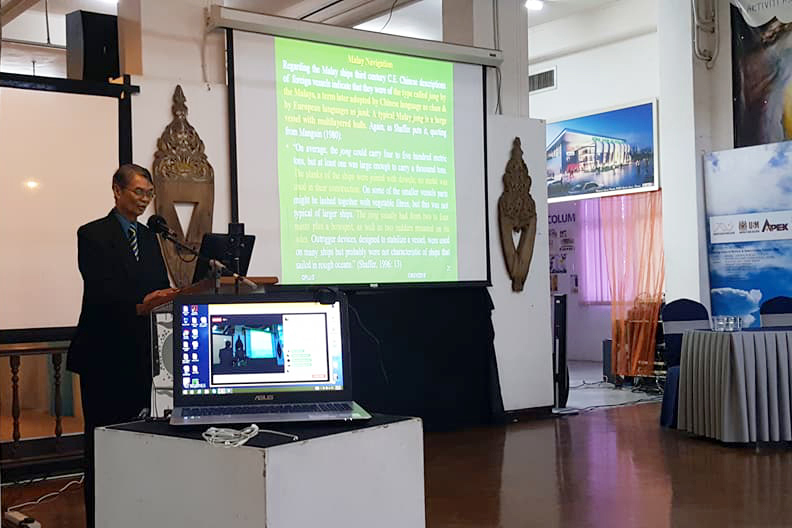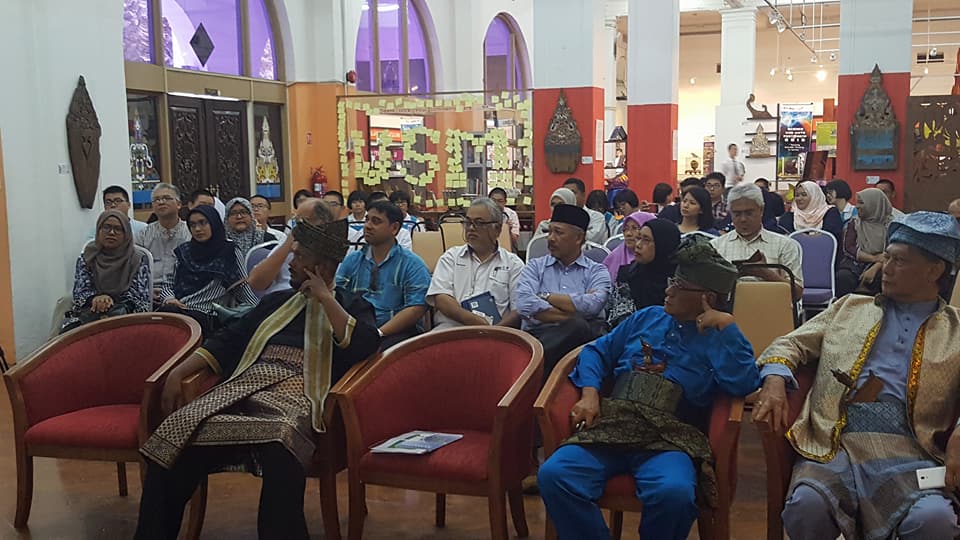PROMINENT USM SCHOLAR SHARED A ‘JOURNEY’ THROUGH MALAY MARITIME HISTORY AT MUSEUM TALK

PENANG, 7 April 2018 – The Universiti Sains Malaysia (USM) Muzium & Galeri Tuanku Fauziah (MGTF) held a public lecture recently, as part of its ‘Science and Arts Fest@MGTF 2018’ programme.
The MGTF programme, with its theme, ‘Reviving Scientific Thinking in Society’, presented a lecture by USM Ombudsman, Professor Dato’ Seri Dr. Md. Salleh Yaapar with the topic on “Malay Navigation and Maritime Trade: A Journey through Anthropology and History”.
Md. Salleh took the audience on a historic trip, looking into the achievements of the Malays, a huge racial group currently dispersed in diverse parts of the world, from Taiwan (north) to New Zealand (south), and from Easter Island (east) to Madagascar (west). The Malayo-Polynesian and its many sub-ethnic groups have had many achievements throughout civilisation, but which have yet to be widely shared and clearly understood.
The focus of Md. Salleh’s talk highlighted the navigational and maritime feats of the Malays throughout history. The Malays have been mentioned in the texts of Ptolemy (90-168 CE) and Wan Zhen (3rd century), being referred to by the former as ‘Maleu-Kolon’ and the latter as ‘Kunlun’.

He said that the Malays of yore have established their presence since the times of Kedah Tua (535 BCE) to the Srivijayan Empire, then onwards to Champa (Indo-China) and Jambi, Sumatera. They have been identified to have built a Hindu monastery in India (860 CE), mentioned repeatedly by I-Tsing in his journeys (671 CE, 689-695 CE) and they also constructed the famed Borobudor (770-825 BCE) in Indonesia, being referred to as ‘Malayo’ there. I-Tsing had also referred to the Malays as ‘Kunlun’ then. They have travelled to Malagasy, with their descendants remaining there until now using the Ma’anyan language.
With the arrival of Islam in 674 CE, Md. Salleh said that it slowly replaced Hindu in the lives of the Malays. The Malaccan Empire replaced Srivijaya and the language used the ‘Jawi’ script in their writings. Malacca thrived as a port, with traders coming from India, China and the Arab nations and it also became a melting pot of cultures while its trading activities flourished.
The Malays in history have been known to navigate the seas since 3rd century BCE, mainly to do trade with nations from Europe to East Asia and the East Coast of Africa.
Md. Salleh added, the Malays traded and travelled across the oceans on large ships and they have been referred to by Wan Zhen as ‘great shipbuilders’ in describing the type of ships they had used then. The Malays were skilled in building huge ships, having advanced ‘celestial’ navigational skills and were involved in long-distance maritime trade.
The Chinese learned a lot from the Malays in relation to shipbuilding techniques, with the balance-lug sail being a sail design of global significance, stated Md. Salleh. The design would later inspire the use of ‘lateen’ triangular sails by other nations.
The ships built by the Malays were of much bigger size than the Chinese jongs or even the Portuguese galleons, with Alfonso de Albuquerque was reported to have said that the Malay ships or ghalis (galleys) as ‘World Shakers’. Hang Tuah, the Malay warrior was said to have used the ship of Sultan Mahmud Shah, the ‘Mendam Berahi’, in his journeys to other lands. It was due to this fact that the Malays then could be found in diverse part of the world, covering two-thirds of the southern hemisphere.
The Malays were also actively involved in maritime activities. Trading was the main motivation for navigators and sailors, said Md. Salleh. The Malays traded numerous products and items wherever they went, going to Yemen and other parts of the Middle East (cinnamon), to Eastern Africa and Madagascar (bananas, coconuts, cocoyams, chickens).
Apart from trading goods and natural products, the Malays also brought along cultural influences to societies they came in contact with, Md. Salleh further explained. When the Malays traded items such as ‘kayumanis’ (cinnamon), the Greeks used the word, through the Phoenician and Hebrew languages, and it became ‘kenela’. The African Igbo language has ‘edi’, which came from the Malay word ‘keladi’ (yam).
The Malays went to East Asia and traded rice with the Chinese as early as 3rd century BCE. The Malays from Champa (IndoChina) exported the ‘pokok pinang’ (areca tree) and ‘pokok padi’ (paddy/rice plant) as the Chinese favoured the rice variant from the Champa Malays. By 1012 CE, the rice variant could be found even in the lower Yangtze and Huai river regions.
Md. Salleh continued, the ‘buahpinang’ (areca nut) was also exported by the Malays and cultivated in parts of China such as Guangdong, Yunnan and Fujian. It was referred to as ‘bing lang’ in the Mandarin language. Other items that were traded and their names adapted were ‘sagu’ (sha-hu), ‘kapas’ (ji-bei), ‘nipah’ (mi-pa) and ‘kajang’ (jiao-shang). Even the name of the official Chinese language ‘Mandarin’, meaning ‘Language of the Officials’, was taken from the Malay word ‘menteri’ (minister).
Other than exchange of products and adaptation of words, skilled workers were also sent to China, where there were descriptions of ‘Malay slaves or workers’ (Kunlun nu). They resided especially in Guangdong, teaching martial arts or becoming personal or security guards. Their activities have inspired many amulet makers (for graves) and the ‘wuxia’ film genre. Examples include a book by Pei Xing (825-880 CE) called ‘Kunlun Nu’ and a film called ‘The Promise’ (2005).
Md. Salleh continued by stating that the Malays also traded extensively with India. Ties have been established as far back as 1900 years ago at the ‘Kedah Tua’ (Kadaram/Kalaha/Cheh Cha) port, with its iron-smelting activities. In the 12th century, al-Idrisi mentioned it in his writing ‘Ar-Rujjar’. In 535 BCE, Kedah Tua had export activities to India, the Middle East and Sofala (a province in Mozambique). The Kedah Tua/Sg Batu port has been proven to be the oldest civilisation in Southeast Asia, with the discoveries of sites, structures and artifacts by the USM Centre for Global Archaeological Research (CGAR).
Although Kedah Tua was later subjugated by the Srivijayan Empire in the 7th century, trade and maritime activities were not affected, and continued through the trans-peninsular routes via the Muda and Pattani rivers. This in part enhanced trade between China and India, said Md. Salleh.
When Srivijaya was raided by a king from Tamil Nadu in 1025 CE, trading activities were weakened. However, trade activities increased again when Malacca grew to become a great port from 1400 CE until the 16th century. Trade and diplomatic relations had been established then with China, India, Japan, Turkey and some Islamic Caliphate nations. The Malacca port was said to have hosted close to 2000 sea-going vessels. Trade was conducted among the many nationalities in secured harmony, and using more than 84 languages. Malacca became a maritime powerhouse in the 15th century, described Md. Salleh.
The Malays then were skilled shipbuilders, navigating across the seas using knowledge and expertise of the natural elements and were exceptional traders. Females have even been reported going on outrigger ships. Not only they made an impact in terms of monetary and material gains, there were also anthropological and socio-cultural impacts made in the many different locations. The Malays could now be found in 60% of locations around the world, and which occurred without any reported acts of force or violence, Md. Salleh said.
In ending his talk, Md. Salleh said that such narrations are no longer widely discussed in public. It would be a great loss to the civilisation of mankind if such knowledge would not be explored and documented further. He recommended that for those in authority and having the interest to continue pursuing the matter and to promote greater awareness on the achievements.
Held at MGTF USM, the talk was part of a month-long programme by the museum, in collaboration with other USM schools, departments and external bodies. Those present include Heads of Departments, university officials, academicians and students.
Professor Dato’ Seri Dr. Md. Salleh Yaapar is the USM Ombudsman and was a former USM Deputy Vice-Chancellor. He is currently a Distinguished Fellow at the International Islamic University Malaysia (IIUM) and was a former holder of the European Chair of Malay Studies at Leiden University, the Netherlands. He has also served and is serving in various capacities as advisor and researcher, and has won numerous awards in the field of literature.
Text: Mazlan Hanafi Basharudin
- Created on .
- Hits: 4013
